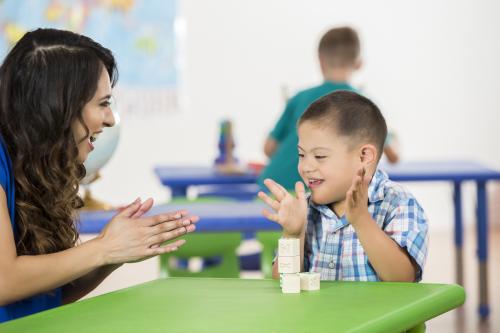Administrators of Preschool Special Education
The Preschool Special Education (PSE) administrators webpage is designed to assist superintendents, preschool special education administrators, special education administrators, and elementary school principals in supporting preschool students with disabilities.
Why is Preschool Special Education Important?
According to the joint policy statement from the U.S. Department of Health and Human Services and Education on the inclusion of children with disabilities in early childhood programs, it is expected that children are included “together with their peers without disabilities; holding high expectations and intentionally promoting participation in all learning and social activities, facilitated by individualized accommodations; and using evidence-based services and supports to foster their development (cognitive, language, communication, physical, behavioral, and social-emotional); friendships with peers and a sense of belonging.” Research presented in the policy statement shows the academic and social benefits for children with disabilities taught in integrated settings. Children without disabilities also benefit from these settings, having more positive social development and attitudes toward differences, diversity in ability, and inclusive experiences.
The ultimate goal for preschool special education is “to enable young children to be active and successful participants during the early childhood years and in the future in a variety of settings - in their homes with their families, in childcare, preschool, and in the community” (Early Childhood Outcomes Center, 2010).
Understanding Preschool Special Education
There are many ways an administrator can support both their preschool and K-12 special education programs. One way is to bring together preschool and K-12 systems while understanding and honoring the similarities and differences. Review the resource Preschool and K-12 Special Education Similarities and Differences to learn more.
While ideal, the most appropriate placement for all children with disabilities may not be a regular early childhood setting. Rather, the aim is to place the child in the Least Restrictive Environment (LRE) with the necessary supports and services based on the needs of the individual child and family. These decisions are made by the Individualized Education Program (IEP) team, which includes the family as an equal partner.
Preschool Special Education in Your District
Strong leadership and administrator support are key to the success of preschool special education programs. Here are some tips for learning everything you can about preschool special education and getting more involved:
- Start by developing a close working relationship with the Preschool Special Education Coordinator in your district and ask them directly what you can do to support programming.
- Consider including the preschool staff in newsletters, communications, and meetings that occur as part of the K-12 system.
- Encourage the Kindergarten teachers in your district to reach out to the preschool special education staff, especially to build relationships that support smooth transitions between preschool to Kindergarten.
- Facilitate meetings between Kindergarten and preschool special education teams.
- Reach out to your preschool special education, preschool, and pre-k programs to see what support they may need from you as an administrator.
- Ask to be informed about the events happening for preschool special education, preschool, and pre-k programs; plan to attend some of the events to begin building relationships with preschool children and families in your district.
- Share with your school board the importance of preschool special education in your district.
Another important resource for PSE Administrators is Supporting Children with Disabilities: A Guide to Understanding Early Childhood Special Education Systems, developed by Race2K. This guide provides tools and strategies for examining the district’s system for providing services to preschool-aged children with disabilities through the lens of preschool children with disabilities who have access to the Least Restrictive Environment (LRE).
Federal Reporting Indicators for Preschool Special Education
The IDEA requires states to submit annual reports, the State Performance Plan/Annual Performance Report (SPP/APR), which the Monitoring and State Improvement Plan (MSIP) within the Office of Special Education Programs (OSEP) uses to ensure that states implement programs designed to improve results for children with disabilities.
IDEA Indicator 6: Early Childhood Environments
The Federal Office of Special Education Programs (OSEP) requires states to annually collect and report data on educational environments. For grades K-12, Indicator 5 is the educational environments data collected. For New Hampshire, Indicator 6 is measured by the percent of children aged 3 through 5 with IEPs attending a:
- Regular early childhood program and receiving the majority of special education and related services in the regular early childhood program,
- Separate special education class, separate school or residential facility, and
- Receiving special education and related services in the home.
IDEA Indicator 7: Preschool Outcomes
OSEP requires states to measure and report the extent to which preschool children aged 3 through 5 with IEPs who demonstrate improved:
- Positive social-emotional skills (including social relationships)
- Acquisition and use of knowledge and skills (Including early language/communication and early literacy)
- Use of appropriate behaviors to meet their needs
IDEA Indicator 12: Early Childhood Transitions
OSEP requires states to collect and report data on the percent of children that transition from Part C (Family Centered Early Supports and Services) to Part B 619 (Preschool Special Education Services) with an IEP developed and implemented by their 3rd birthday. All children referred to special education by FCESS must have an eligibility determination prior to age 3. If eligible for special education, these children must also have an IEP developed and signed by the child’s third birthday.
Resources and More Information on the Federal Indicators
Indicator 6 Fact Sheet
Indicator 7 Fact Sheet
Indicator 12 Fact Sheet
LEA Determinations
IDEA Part B State Performance Plans/ Annual Performance Reports (SPP/APR) Indicator Analysis Booklet
State Performance Plan, Annual Performance Plan and Indicators




